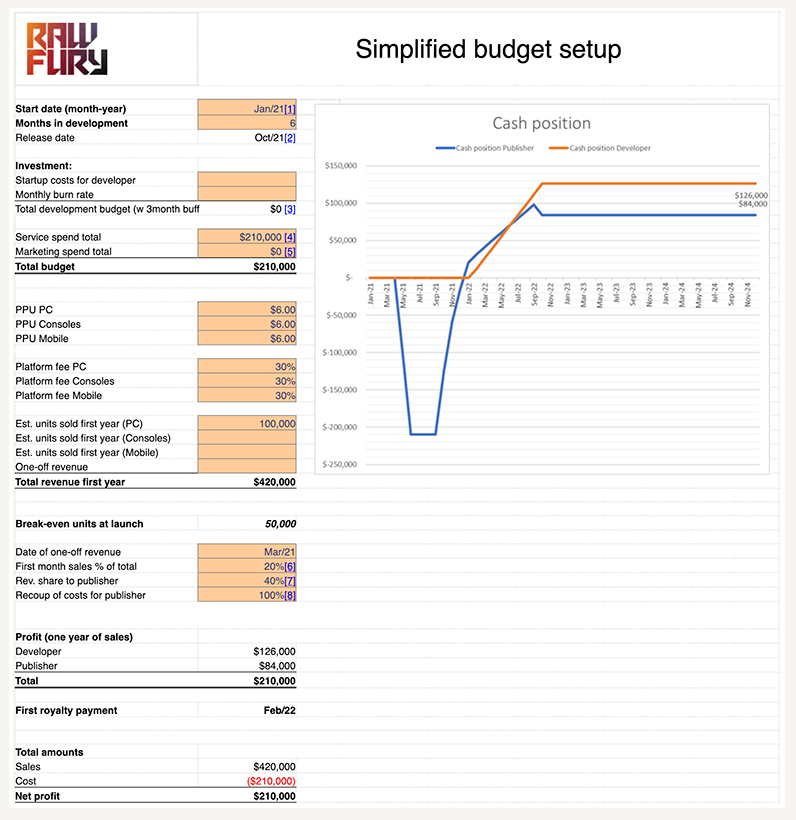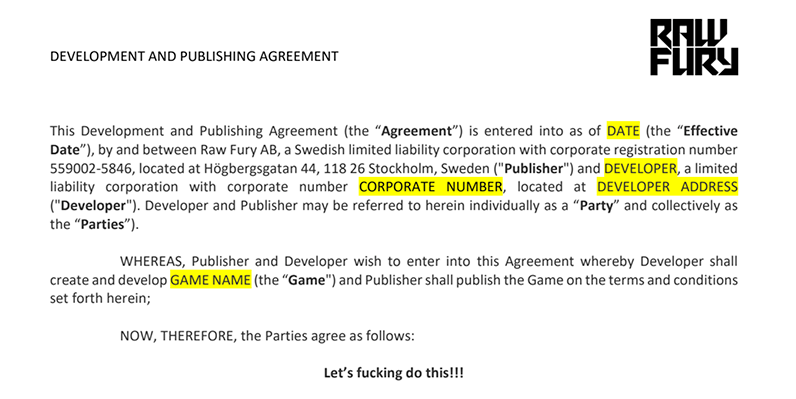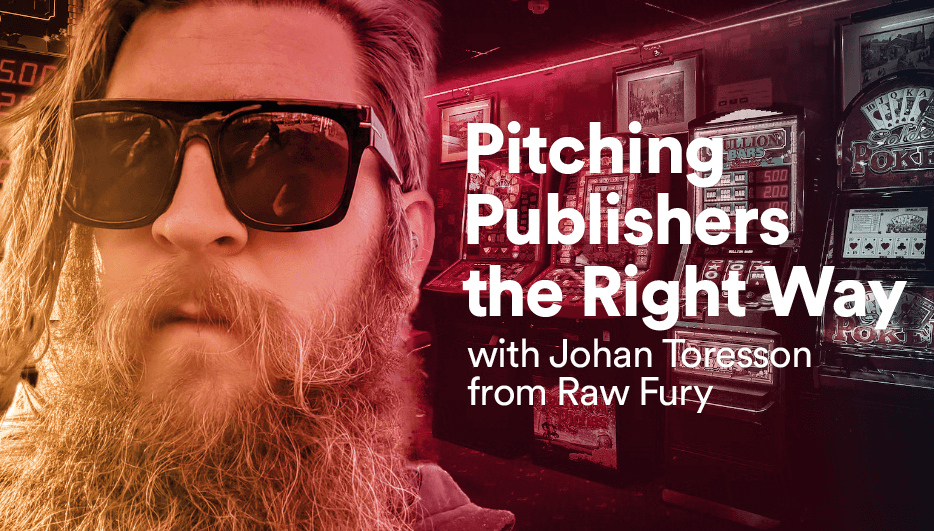Lots of game developers want a publisher to help finance, market, and distribute their game. And that means approaching and pitching publishers (or investors). But it can be tough to know how to do that in the right way. Don’t worry though – we’ve been talking to Johan Toresson, “chief say-that-again officer” at Raw Fury, to get the lowdown on how to do just that.
Before the pitch
Why pitch at all?
Well, it depends on what you need, and what you’re set up to do yourself. “If you have the time, money, and people to self publish,” says Johan, “why not do it yourself?” But if you don’t, or you’d rather just spend your time making games, finding a publisher could be the way forward. They can also give you access to audiences and networks that you might not be able to find on your own. After all, just releasing a good game doesn’t guarantee tons of players and success.
How should I get in touch?
Obviously it depends on the publisher. “Most publishers have a preferred way of getting pitches to make sure stuff doesn’t get lost,” says Johan. “For Raw Fury, that’s by email.” Doing it in person probably isn’t going to get you any extra points either. There might be some benefits – like giving the publisher a chance to ask questions – but ultimately whether you start with an email or a meeting isn’t going to affect the final decision.
The good news is that you don’t need to have an existing relationship with a publisher before pitching your game either. “Most games I sign come from devs I had zero relationships with before their pitch,” says Johan.

If you’re just looking to ask a question, maybe with a view to pitching later, posting it on social media (not by DM) is a good bet. You might not get an answer straightaway. But according to Johan, if it’s something that might be useful to a lot of people, the chances of it getting answered increase. “Even fairly specific questions might have general interest, so feel free to go at it!” Case in point, one of Raw Fury’s most recent hits, Dome Keeper all started when Johan reached out to the developer via Twitter.
What stage should my game be at when I pitch it?
“Impossible to answer,” says Johan. “It depends on the game.” But you do need to be able to prove you can deliver on the promise of the pitch. And that will depend on if you’re building a platformer, real-time strategy, RPG, or PVP first-person shooter, and so on. The amount of budget you have is of course going to play into this as well.
Announcing your game before you pitch is also up to you. Johan says to avoid announcing specific platforms though as a publisher will want to have a say in that. Building traction and hype is part of a publisher’s job too, so don't be worried if your gifs haven't gone viral on Reddit. Instead, figure out how to speak to your audience and identify what engages them, and why.
Do I need an experienced team to pitch successfully?
Not necessarily. Experienced teams might find it easier to get signed than ones that are just out of school – it means there’s less risk for the publisher. That said, a good project with smart people without much experience definitely has just as good a chance as well. “Tons of good student projects, or projects from folks who never made games before, are out there,” says Johan. “Risk of Rain, Backbone, and Norco all came from teams that were either just out of school, or had little to no game industry background.”
You will want your team to be complete though. Or if it isn’t quite there yet, you’ll need to have a concrete plan in place for getting it up to full strength. According to Johan it’s preferable to have named candidates on standby who’ve committed to join once you get funding.
Doing the pitch
What should I do first?
Every pitch is different, but there are some common formats that you can adhere to. Before you do anything, put together a couple of sentences that describe your game’s concept and gameplay. Get straight to the point, focus on the genre, and use examples of other games it’s similar to if you can.
Assuming you’re approaching a publisher cold, you’ll probably be starting with an email. Introduce yourself and say why you think XX Publisher would be great for your game (for example if they have others in their portfolio already that are similar, or even just because you’re a fan). Then use that description you came up with above. And finally, make it clear exactly what you want – funding, marketing, QA, porting, and so on. Then attach your pitch deck (more on this later) and a demo.

Johan says that the three most important elements of your pitch are: “An interesting premise, a build that shows you understand how to make that premise come to life, and a budget that isn’t completely off the rails.”
Is there a particular format I should use for the pitch?
PowerPoint is your friend for your written pitch. “We want a deck that helps us understand who’s building this, why you’re building it, when you think it’ll be done, and a high-level description of exactly what it is you’re making,” says Johan.
You’re likely to want to include some or all of the following in your pitch deck:
- information on your team
- the game’s story
- gameplay mechanics and footage, videos, or screenshots
- its unique selling points – what makes it different to everything that’s already out there?
- similar titles
- possible audiences
- a development roadmap
- a budget
If that all sounds a bit daunting, head to Raw Fury’s developer resources page. There’s a pitch deck template you can use to get started, based on what Raw Fury (and many other publishers) want and expect. There are also tons of resources online including examples of other game pitches, fake pitch deck examples, and even this great thread from Jane Pinckard, Director of Global Portfolio for Xbox.
What about the demo?
The build is really important – it’s unlikely you’ll get signed on concept art alone. Include a playable PC build that captures the essence of what you want to build. “Make sure it conveys that in a way that makes sense for people who aren’t in your team,” says Johan.
It doesn’t need to be perfect. But it does need to explain the objective of the game clearly.
How detailed should the budget be?
Johan says your budget should show development-related costs for one PC build in US dollars. “No need to add marketing, ports or so on – we can figure that out together later on. Basically, what we want is your burn rate times the months left in your development.”
The budget needs to show that you understand your own development costs over a timeline. “We want to know that you get how much work goes into each thing.”

Is there anything else I should add?
“Anything you think is going to help us better understand what you want to do and how you’re going to get there,” says Johan. So that could be GIFs, videos, a GDD, concept art, or story documents.
It’s also good to show that you have some sort of audience already, for example with Twitter followers or popular tweets, TikTok subs, etc. Johan recommends checking out WINGS’ CEO and co-founder Cassia Curran’s talk on how to research the market for help with this.
What happens at a pitch meeting?
First of all, don’t panic. Game publishers are pretty friendly. And they’ve already seen your pitch deck and demo, so they must like what you’ve made. It’s likely to be a fairly informal meeting, and you won’t get an offer there and then – that’ll come later.
You’ll probably go through your pitch, answering questions along the way. The publisher might also have questions about your budget or roadmap, so make sure you’re familiar with what you’ve already provided. And most importantly, be yourself. Publishers are used to speaking with nervous game devs, so don’t worry if it all feels a bit daunting.
After the pitch
What happens if the publisher likes my pitch?
At Raw Fury, the next step is for Johan to show the pitch to the rest of the company, and make sure they’re seeing what he sees. If they do, then it won’t necessarily be that long before you get a deal on the table. How long varies wildly – “The shortest time between reading a pitch and giving a dev a deal is probably two to three weeks. And the longest is maybe half a year to eight months,” says Johan.

Negotiating publishing deals can be tricky, especially for the uninitiated. But you should have a conversation to make sure both parties feel they can trust and understand the other. “Development is fickle and there are often hiccups along the way,” Johan says. “If you don’t trust your partner to be able to sit down and discuss those hiccups, you shouldn’t sign – it doesn’t matter how sweet the deal is.”
Raw Fury have graciously shared their publishing agreement (and other legal docs) on their website. That means you can check what a deal will look like before you even put finger to keyboard for a pitch doc. “When we talk about a deal it’s clear that the terms are the terms, and everyone we work with has the same deal,” says Johan. “We might make some changes if we find the wording works against the goal of the contract though – like right of first refusal when in reality we always treated it as right of first offer.”
What happens if the publisher doesn’t like my pitch?
Just because publishers pass on a game doesn’t mean you should bin it. Maybe they didn’t understand the genre, maybe it doesn’t fit their portfolio, or “maybe they’re just daft,” says Johan. “For every game we sign, there are probably another two we should have but didn’t. And they go and do perfectly well (and sometimes better) with another publisher or by self-publishing.” So don’t give up. And remember that you’ll learn something from every pitch, whether it’s a deal-winner or not.
What not to do
What are some of the mistakes game developers make when pitching to a publisher?
First of all, do your research. Understand what individual publishers are looking for – it’s no good pitching a first-person shooter to someone if it’s a genre they never publish, for example.
Johan reiterates the importance of getting the budget right too. “A disconnect between the pitch and the budget is definitely a red flag for me. It wouldn’t necessarily kill a pitch completely, but it would ring some alarm bells.”
He also has some advice about pitch meetings. “If you have, say 30 minutes for a meeting, don’t build a pitch that’s 30 minutes long.” If you’re following the advice in this post, you will have already sent your pitch deck to the publisher. “Get through that as fast as possible so you can spend the rest of the time in a two-way dialogue with the publisher. I don’t need you to go through something I’ve already read. You have my attention, I’m at the table – make use of me. If you just want to show me slides, send me an email.”
Looking for more pitching tips?
Follow Johan on Twitter, and check out Raw Fury’s guide to pitching.
We’d also like to say a big thanks to Johan for sharing his thoughts with us.
